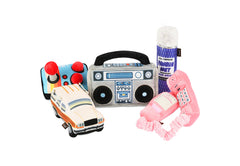Does your dog tend to become overly aggressive every time you leave them alone at home? Or do they whine and growl at the mention of going to the vet’s office? Perhaps your dog gets exceptionally nervous every time you take them for a car ride?
If you have noticed any of the above signs in your pooch, they are likely experiencing some form of anxiety.
That’s right. Canine anxiety is a real thing that you need to watch out for. As a dog parent, it is your responsibility to relieve your canine companion’s anxiety and calm their nerves. This is essential because dogs aren’t programmed to communicate the way humans do.
It is, therefore, up to you to monitor their behavior and identify any warning signs of anxiety. The good news is that there are various ways to help your dog cope with stress and anxiety. In this blog, we will discuss a few such techniques. But let us first delve deeper into the world of canine anxiety.
Can Dogs Suffer from Anxiety?
First things first - occasionally demonstrating anxious behavior is fairly normal for dogs. Lifestyle modifications, including a change in routine or living space, can trigger anxiety. Likewise, your dog might become fearful in anticipation of a stress-inducing event, such as a thunderstorm or fireworks.
However, if the symptoms persist, it is a cause for concern. Chronic anxiety can adversely affect your dog’s physical health and mental wellbeing. Also, it can compel them to indulge in self-harm. That’s why you should know about the different types of canine anxiety and use effective techniques to alleviate them.
Typically, anxiety in dogs manifests itself in the form of:
- Separation anxiety
- Fear-related anxiety
- Age-related anxiety
Separation anxiety is extremely common in dogs. As the name suggests, it is triggered by separation from a dog’s guardian or favorite humans. If your dog becomes aggressive and whiny or indulges in destructive behavior every time you leave the house, chances are they have separation anxiety.
Fear-related anxiety is caused by a diverse array of factors, including loud noises, unfamiliar environments, strangers, and undesirable situations. The most common form of fear-related anxiety is when your dog becomes nervous while going to the vet. Or they might become fearful when a new house guest arrives.
Age-related anxiety is prevalent in older dogs who suffer from cognitive dysfunction syndrome (CDS). It impairs their cognitive abilities and memories, thereby making them vulnerable to stress and anxiety.
What are the Symptoms of Canine Anxiety?
There isn’t a one-size-fits-all formula to diagnose canine anxiety. The symptoms depend on various factors, including your dog’s age, breed, overall health. However, here are a few common signs you should watch out for:
- Excessive barking, growling, whimpering or whining
- Extreme aggression
- Defecating or urinating in the house when left alone
- Shaking and trembling
- Drooling
- Panting
- Restlessness
- Loss of appetite
- Lower energy levels
- Self-harm
- Destructive behavior
- Excessive grooming
Additionally, your dog can exhibit compulsive behavior, such as constantly pacing up and down the hallway. They might also have an elevated heart rate, as well as skin rashes due to self-harm or excessive grooming.
How to Control Anxiety in Dogs?
Just because your dog suffers from fear-related or separation anxiety, it doesn’t mean the end of the world. There are plenty of things you can do to calm your dog’s nerves and help them cope with stressful situations. Here are a few useful tips to manage canine anxiety:
1. Consult Your Vet
Here’s the thing - the symptoms of canine anxiety often overlap with more serious underlying medical conditions. It’s really difficult to understand if your dog isn’t eating because they’re stressed or have an abdominal infection. That’s why you should immediately book an appointment with your veterinarian as soon as your dog exhibits any symptoms of anxiety.
Also, it is a good idea to maintain a record of your dog’s symptoms. You can write them down or capture them on your phone. It can go a long way to help your vet diagnose the root cause of their anxiety and suggest a suitable treatment plan.
Typically, your vet will prescribe behavioral modification techniques, such as counterconditioning and desensitization. Also, they might prescribe medication, such as antidepressants and benzodiazepines. Even if you have access to these medicines, make sure you never administer them without your vet’s approval.
2. Don’t Skip Exercise
Taking your dog out for a walk or to play fetch can help them burn excess energy and calm their nerves. Also, it’s a great way to spend some one-on-one bonding time with your furry friend. Create a proper exercise routine for your dog in consultation with the vet.
3. Consider Alternative Therapies
Alternative treatment options, such as CBD oil and valerian root for dogs, are known to help with anxiety. If you’re skeptical about giving allopathic medicines to your dog, these natural remedies are a great choice.
However, there isn’t enough concrete scientific evidence to support the effectiveness of these treatments. So, make sure you discuss it with your vet and ask them to prescribe the right dosage.
4. Try Music Therapy
Listening to soft and soothing music doesn’t just help you relax. It can also be instrumental in helping your pooch cope with anxiety and stress. In fact, studies have shown that classical music tends to have a calming effect on shelter dogs. So, the next time your dog starts acting up, try playing some music to pacify them.
While anxiety is inevitable for your canine friend, you can improve their quality of life with the right measures. What techniques have you used to help relieve your dog’s anxiety? Share your tips in the comments section below.






